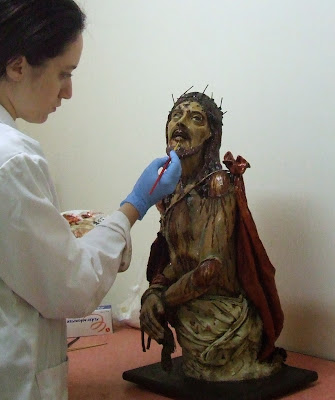The Ecce Homo polychrome sculpture before and after conservation-restoration treatments.
Manufacturing Technique: This polychrome sculpture is a composite object, since each part was manufactured by using different materials. The figure of Jesus Christ was cast solidly in gesso, while the mantle and cloth around His waist were made using the technique of papier mâché. Imitations of the ripped skin around the elbows and on the torso were molded separately, probably with gesso.
The medium of the paint layer is probably oil.
The crown was manufactured from real stems of trees, which were tied together with pieces of string.
Past Restorations: The sculpture was damaged at some point in the past since it could be observed that cracks on the head and torso were fixed together again with a type of thick glue. This glue is still functioning, and these areas seem to have been stabilized.
The varnish present was probably also applied during a past restoration intervention.
State of Conservation: The structure of the polychrome sculpture is in an overall stable condition. It had some hairline cracks on various areas, while the thumb of one of the hands and other parts were completely detached from the rest of the sculpture. Some losses of the paint layer were observed on the lower part of the red mantle, exposing the underlying textile support. A puncture in the gesso was also observed on the forehead of Jesus Christ.
However, the most significant problem which this sculpture presented was the oxidation of the varnish into a very dark brown layer which was obscuring the paint layer heavily. Further non-invasive investigation in using ultra-violet light confirmed the presence of varnish, due to the resulting yellowish-green fluorescence.
Conservation-Restoration Treatments:
Cleaning and Consolidation
An appropriate cleaning procedure was tailored in using organic solvents that were the most effective in terms of their solubility parameters to remove the thick, brown varnish layer present.
During cleaning, it was observed that black residues had settled inside crevices, while wax droppings were present onto the hands. These residues were both present underneath the varnish layer. In order to remove them, a solvent gel was prepared and it was used to soften the residues and droppings. This enabled easier removal mechanically using a scalpel blade.
Consolidation of detached areas was done simultaneously with the cleaning procedure. An organic adhesive which is compatible with the original, was used for this purpose.
Reintegration of Lacunae
Lacunae and cracks were infilled using a compatible mixture with the original constituent materials.
Lacunae on the face of Jesus Christ and the red mantle, after application of infills.
Reintegration of lacunae was carried out in using compatible colours with the original paint layer, and which are also reversible.
A final varnish layer was then given. The varnish applied has the appropriate reflective properties and it is also reversible.
Images and text are copyright Sarah Yeomans Gafa` 2013.
The medium of the paint layer is probably oil.
The crown was manufactured from real stems of trees, which were tied together with pieces of string.
Past Restorations: The sculpture was damaged at some point in the past since it could be observed that cracks on the head and torso were fixed together again with a type of thick glue. This glue is still functioning, and these areas seem to have been stabilized.
The head of Jesus Christ; showing an area where the sculpture was damaged in the past and fixed with a thick glue.
The varnish present was probably also applied during a past restoration intervention.
State of Conservation: The structure of the polychrome sculpture is in an overall stable condition. It had some hairline cracks on various areas, while the thumb of one of the hands and other parts were completely detached from the rest of the sculpture. Some losses of the paint layer were observed on the lower part of the red mantle, exposing the underlying textile support. A puncture in the gesso was also observed on the forehead of Jesus Christ.
A detailed photograph of cracks shown on the arms (photograph taken during cleaning).
Detailed photograph of the face of Jesus Christ under ultra-violet fluorescence. The sculpture fluoresced yellowish-green thus, confirming the presence of a varnish layer.
Cleaning and Consolidation
An appropriate cleaning procedure was tailored in using organic solvents that were the most effective in terms of their solubility parameters to remove the thick, brown varnish layer present.
During the cleaning procedure of the polychrome sculpture (front).
During the cleaning procedure of the polychrome sculpture (verso).
Photographs taken during cleaning; black residues which settled inside crevices, and wax residues on one of the hands were discovered underneath the varnish layers.
During the cleaning procedure, the sculpture was frequently checked under ultra-violet light in order to ensure that the varnish layer was being successfully removed and no residues were left on the surface.
Consolidation of detached areas was done simultaneously with the cleaning procedure. An organic adhesive which is compatible with the original, was used for this purpose.
During the process of consolidation.
Reintegration of Lacunae
Lacunae and cracks were infilled using a compatible mixture with the original constituent materials.
Reintegration of lacunae was carried out in using compatible colours with the original paint layer, and which are also reversible.
During the procedure of reintegration of lacunae.
A final varnish layer was then given. The varnish applied has the appropriate reflective properties and it is also reversible.
Images and text are copyright Sarah Yeomans Gafa` 2013.











Hi Sarah,
ReplyDeleteWe have a 16th/17th Century Virgin and Christ polychrome figure, which has been in a barn for the last twenty years.
We wish to clean and preserve it.
What is the best wat to gently clean it and to stop any future lose of paint, can it be given a light coat of matt varnish?
David